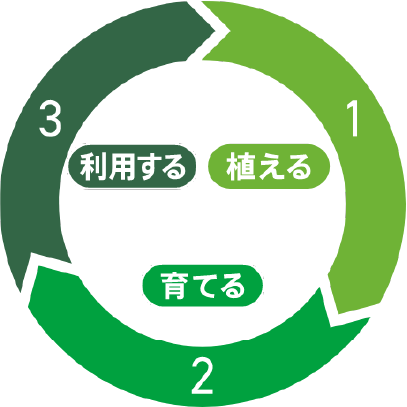Oji’s Forests Around the World
"Oji’s Forests" is a sustainable forest that Oji Group nurtures in Japan and around the world.
The philosophy that lives within the Oji Group, to which nepia belongs, is:
"Those who use wood have an obligation to plant trees."
Guided by this philosophy, the Oji Group has been promoting sustainable forest management since its founding—planting trees, nurturing forests, and appropriately utilizing resources as part of a responsible approach to forestry.
Expanding this effort globally, the forests they have nurtured continuously are "Oji’s Forests."
The total area of Oji’s Forests is approximately 603,000 ha (about 2.75 times the size of Tokyo).
Domestic "Oji’s Forests"
Approximately 650 locations
Around 188,000 ha
Overseas "Oji’s Forests"
5 countries
Around 415,000 ha
Annual number of trees planted
(2019 results)
Approximately 28 million trees
The Global Network of Oji’s Forests
Japan
- Production forests: 176,000 ha
- Conservation forests: 12,000 ha
- Total area: Approximately 188,000 ha
Brazil
- Production forests: 144,000 ha
- Conservation forests: 106,000 ha
- Total area: Approximately 250,000 ha
New Zealand
- Production forests: 53,000 ha
- Conservation forests: 9,000 ha
- Total area: Approximately 62,000 ha
Indonesia
- Production forests: 63,000 ha
- Conservation forests: 19,000 ha
- Total area: Approximately 82,000 ha
Vietnam
- Production forests: 9,000 ha
- Conservation forests: 1,000 ha
- Total area: Approximately 10,000 ha
Others
- Production forests: 10,000 ha
- Conservation forests: 1,000 ha
- Total area: Approximately 11,000 ha
- *Includes operations in Vietnam and Australia from three companies.
Production Forests and Conservation Forests
Protecting both daily life and the planet through two types of forests.
The healthy forest resources cultivated in Oji’s Forests are sustainably utilized in nepia’s key products, supporting everyday life.
At the same time, nurturing forests with diverse ecological functions—such as biodiversity conservation, soil erosion prevention, and water source preservation—also plays a vital role in protecting the global environment.
Production Forests
Forests primarily managed for timber production while considering environmental conservation.
Approximately 455,000 ha
Conservation Forests
Forests primarily dedicated to environmental conservation, including biodiversity and watershed protection.
Approximately 148,000 ha
Protecting the Earth from Global Warming with the Power of Forests—
Absorbing Carbon Dioxide and Releasing Oxygen.
The trees in our forests absorb carbon dioxide (CO₂), a major cause of global warming, and release oxygen (O₂).
By leveraging this natural process, we aim to reduce the increase of CO₂ and protect the Earth from global warming.
This is one of the key reasons why we are committed to nurturing forests.



The cycle of nepia’s product creation is also a cycle that continues to sustain the power of the forest.

The trees in their growth stage absorb the most carbon dioxide (CO₂). Therefore, it is essential to cut down mature trees, utilize them as resources, and then plant new ones to continue nurturing the forest. This cycle of maintaining the power of the forest overlaps with nepia’s product creation cycle.

Nepia is committed to creating products that protect the future of the Earth by harnessing the power of the forest.